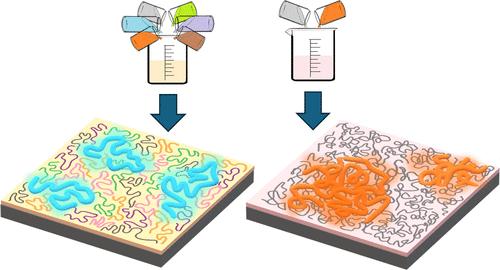Photonics of High-Entropy Polymers Revealing Molecular Dispersion via Polymer Mixing
IF 15.8
1区 材料科学
Q1 CHEMISTRY, MULTIDISCIPLINARY
引用次数: 0
Abstract
Blending multiple polymers together to form the so-called “high-entropy polymers (HEPs)” can generate the effects of molecular dispersion in addition to suppressing polymer phase separation. We embedded a semiconducting polymer (conjugated polymers, CPs) in an optically inert matrix composed of n polymer species and found that a molecule-level dispersion is attained in HEPs defined as n ≥ 5. In the regime of dilute CP concentrations, the photonic properties vary widely in the n = 1 matrices owing to diverse solubility parameters, but the distribution narrows with n, and the CP starts to exhibit behaviors of molecule-level dispersion at n ≥ 5, where the matrix polymers compete with each other to exert direct influences on the embedded CP. Specifically, for MEH-PPV, increasing n reduces the fluorescence redshift and spectral width from diminishing aggregation. For the rigid PFO molecules, increasing n creates a dilution effect facilitating formation of the low-energy planar β-phase. For the flexible regioregular P3HT-rr, HEPs offer well-dispersed amorphous chains highly susceptible to chain environments, thus influencing ηR’s in the quasi-fixed amorphous–crystalline energy transfer landscape. The HEP effects continue for greater CP concentrations, consistent with the matrix dispersing behaviors in the dilute regime. This work demonstrates a molecular-level dispersion by HEPs, offering a method of molecular tailoring for polymer research and applications via simple mixing.

通过聚合物混合揭示分子分散的高熵聚合物光子学
将多种聚合物混合在一起形成所谓的 "高熵聚合物(HEPs)",除了能抑制聚合物相分离外,还能产生分子分散效果。我们将半导体聚合物(共轭聚合物)嵌入由 n 种聚合物组成的光学惰性基质中,发现在 n ≥ 5 的 HEPs 中可以实现分子级分散。在氯化石蜡浓度稀释的情况下,由于溶解度参数的不同,光子特性在 n = 1 的基质中差异很大,但随着 n 的增加,分布逐渐缩小,当 n ≥ 5 时,氯化石蜡开始表现出分子级分散的行为,此时基质聚合物相互竞争,对嵌入的氯化石蜡产生直接影响。具体来说,对于 MEH-PPV,n 的增大会因聚集的减弱而降低荧光红移和光谱宽度。对于刚性 PFO 分子,增加 n 会产生稀释效应,促进低能平面 β 相的形成。对于柔性团状 P3HT-rr,HEP 提供了分散良好的无定形链,极易受到链环境的影响,从而影响准固定无定形-晶体能量转移图中的ηR。CP 浓度越高,HEP 效应越强,这与稀释体系中的基质分散行为一致。这项工作证明了 HEP 在分子水平上的分散作用,为聚合物研究和应用提供了一种通过简单混合进行分子定制的方法。
本文章由计算机程序翻译,如有差异,请以英文原文为准。
求助全文
约1分钟内获得全文
求助全文
来源期刊

ACS Nano
工程技术-材料科学:综合
CiteScore
26.00
自引率
4.10%
发文量
1627
审稿时长
1.7 months
期刊介绍:
ACS Nano, published monthly, serves as an international forum for comprehensive articles on nanoscience and nanotechnology research at the intersections of chemistry, biology, materials science, physics, and engineering. The journal fosters communication among scientists in these communities, facilitating collaboration, new research opportunities, and advancements through discoveries. ACS Nano covers synthesis, assembly, characterization, theory, and simulation of nanostructures, nanobiotechnology, nanofabrication, methods and tools for nanoscience and nanotechnology, and self- and directed-assembly. Alongside original research articles, it offers thorough reviews, perspectives on cutting-edge research, and discussions envisioning the future of nanoscience and nanotechnology.
 求助内容:
求助内容: 应助结果提醒方式:
应助结果提醒方式:


